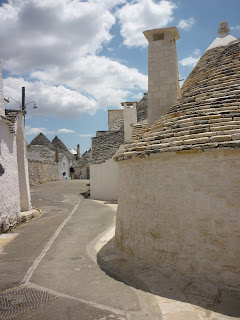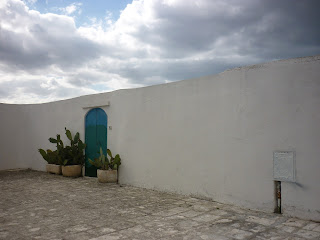Alberobello, Martina Franca, + Ostuni
This trip is going to be separated into two posts because
there is just so much to write about. If you are someone who has wanted to plan
a trip to this area, DO IT! Puglia is full of history, beautiful towns, and
gorgeous beaches. We didn’t really know what we were getting ourselves into
when we booked our flight to Bari. It happened to be the cheapest flight we
could find for this particular 4-day weekend [we flew Air One for those looking
into flights], and we had no idea what Puglia had to offer.
Some history on the area
Puglia, or Apulia [the Latin name for the region] is broken
into 5 provinces, Foggia, Bari, Taranto, Brindisi, and Lecce. It was once
inhabited by the Iapyges, an Indo-European group. Greek colonization’s started
in the 19th century BC, which is why there is still a lot of Greek influence
in the area, and fell to the Romans in 272 BC. Puglia was conquered many times
and there were several wars, but in the end it officially became part of the
Italian Republic. [The full history is much too long to write in here]
The name Apulia is said to derive from the Greek word
Lapudes, which means “those who live on the other side of the Adriatic,” which
seems fitting seeing the history of the area.
Our Italian teacher is from this region so the first step
was to e-mail him to find out some destination suggestions. From there we
decided to visit Alberobello, Martina Franca, Ostuni, Lecce, and Bari, although
once we landed we stopped in a few extra places along the way. We arrived early
Friday morning, rented a car, which if you are stationed in Italy you can rent
it under the Italian rate which is a good 200 Euros cheaper, and headed on our
way to our first stop, Alberobello.
ALBEROBELLO
Alberobello is a beautiful town in the Bari Province and is
about 50 minutes south of the city of Bari. It is most famous for its roughly
1070 Trullo shaped buildings. Most of these buildings are homes and belong to
private residence, however many people love to invite tourists in and show them
their unique style of living. We had a sweet Italian woman invite us in, along
with several other tourists, to show us her home. They are certainly small
homes, but adorable, and compared to a Manhattan apartment, luxurious!
What is the trulli? The trulli is a “traditional Apulian
circular shaped stone dwelling with a squared plan in the interior, and are
built on rocky ground.” The stones are roughly cut and are layered without
mortar. The conical roof is capped with a keystone surmounted by a meaningful
decoration. The origin of the Trullo is “so ancient that similar construction
can be found in Turkey, and in the village of Harran, mentioned in the
Genesis.”
The two Alberobellian districts, Monti and Aia Piccola, are
both UNESCO World Heritage monuments.

 |
| La Chiesa a trullo |

 |
| La Basilica dei Santi Medici |
 |
| La Basilica dei Santi Medici |
 |
| Trullo Sovrano |

MARTINA FRANCA
Martina Franca is well known for its climate, wines,
cereals, and vegetables. It is also said to be the citta d’arte [the city of the
arts] and is located in Valle d’Itria, which is home to many mysterious caves.
The downtown hosts many events throughout the year and its streets are similar
to Venezia, as in maze-like. As we walked through the historical area we
found it to be a traditional setting, where the neighbors all knew each other
and people spoke to each other from their balconies. Families were grilling
outside and bringing food from apartment to apartment and kids played in the
narrow streets surrounding their homes. PJ and I definitely got lost a few
times in this town, however there was always something new to discover with
each turn.
 |
| Porta di S. Stefano |
 |
| Basilica di S. Martino |






OSTUNI
Ostuni has beautiful white washed buildings, staircases,
small roads, arches, and architecture. This town has been around since the
stone ages and was destroyed by Hannibal during the Punic Wars. It was rebuilt
by the Greeks, who named it Ostuni, [Astu neon in Greek meaning “new town”].
Ostuni is built on three hills of Cretaceous limestone with
views opening up to the beautiful Adriatic Sea. Many of the streets are lined
with arches that act as structural support to the buildings. Ostuni is also
known as Citta Bianca [the White City] due to the white wash of the buildings
and the way that the sunlight reflects off the surfaces. It is believed that
the white was used to keep the buildings cool, and that the limestone was used
to act as a disinfectant during epidemics as well as the fact that it is reliably
available all around the city.
 |
| Chiesa di S. Francesco |

 |
| Cattedrale |

 |
| Chiesa di S. Maria della Stella |
 |
| Madonna del Carmine |
 |
| Obelisco di S. Oronzo |






















































No comments:
Post a Comment